Kraków 2009-05-05
311b Section 2003-08-01
Construcciones Aeronauticas SA ( EDAS CASA ) C-295 M
Poland
History
Transport plane.
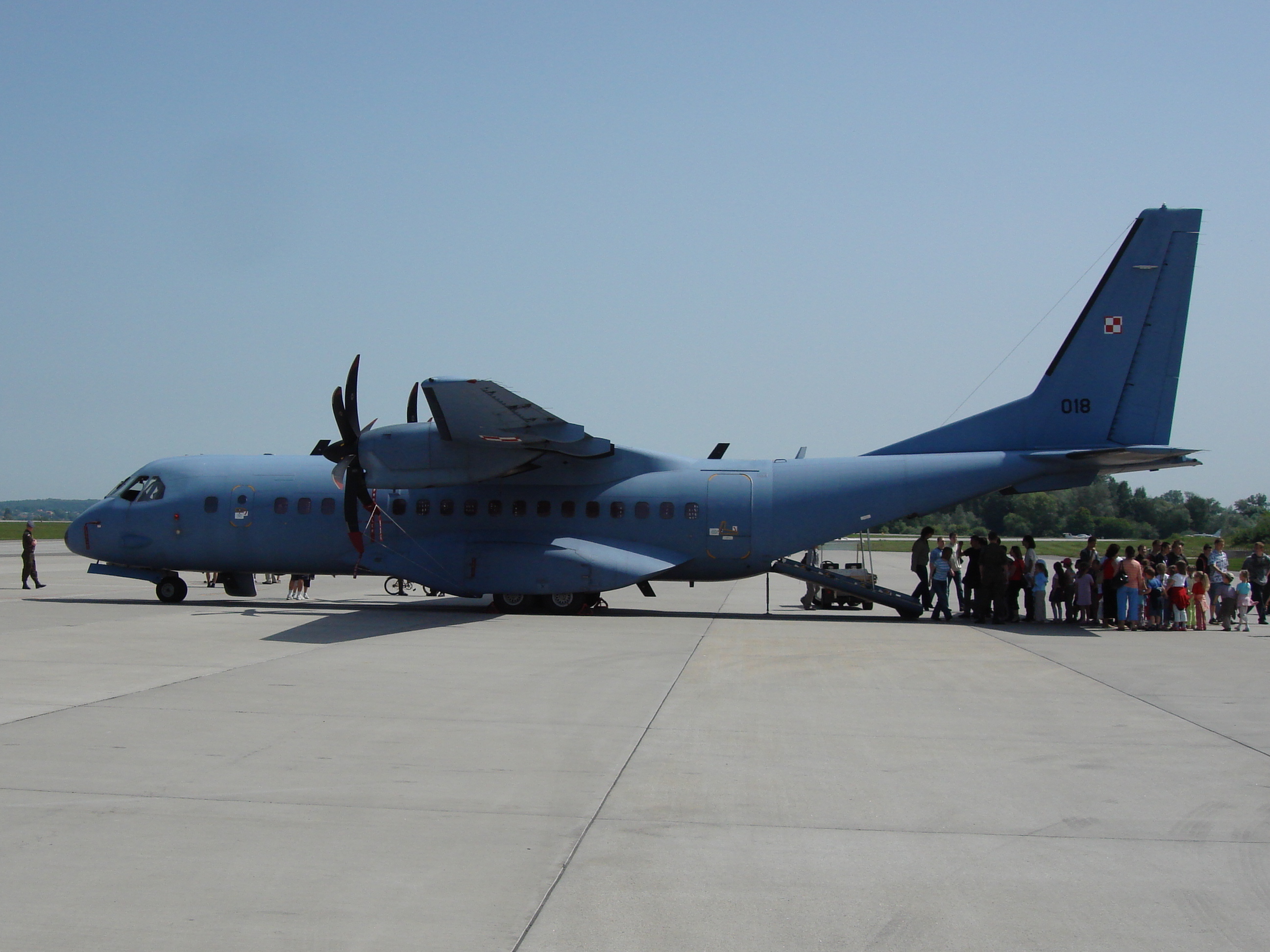
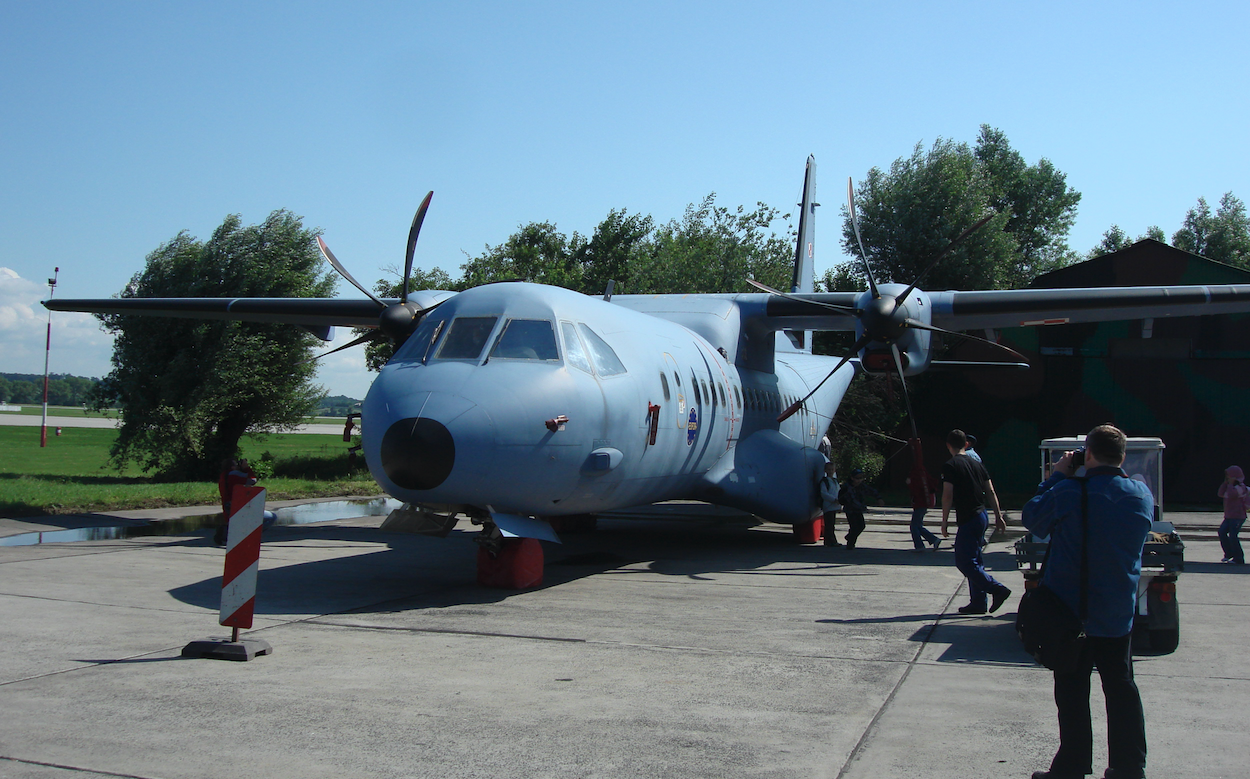
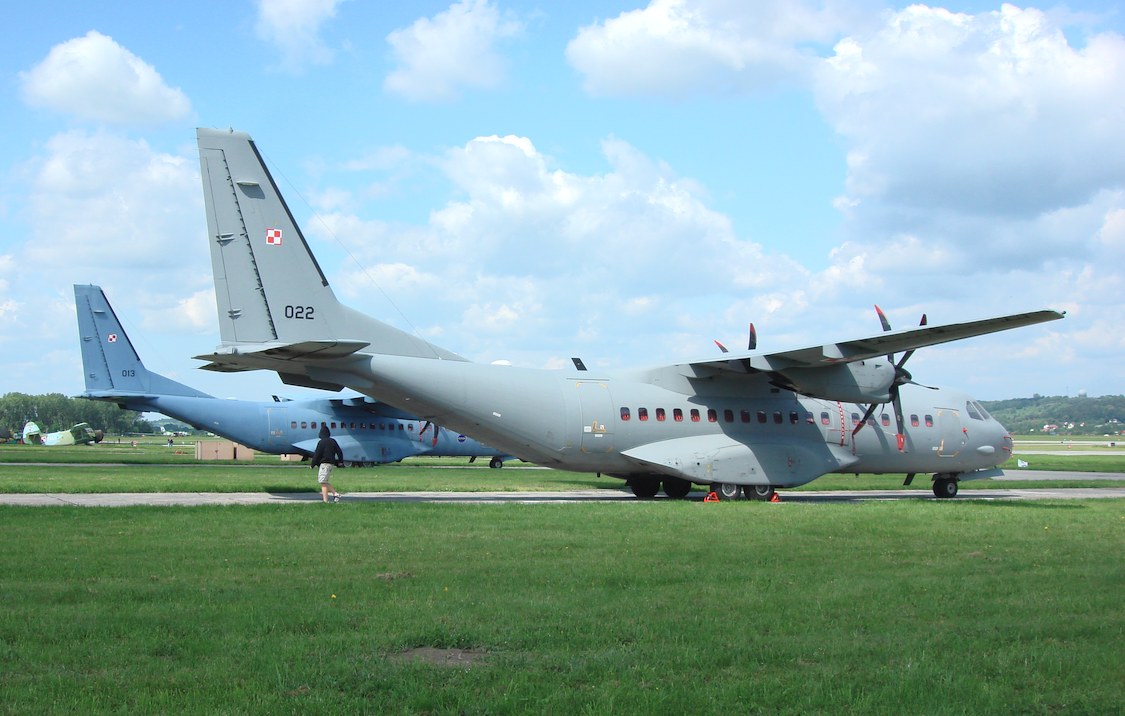
In the 70s of the twentieth century, a large group of new aircraft being developed were light passenger and cargo machines of the STOL class, i.e. shortened takeoff and landing. 14 constructions were developed, including 9 with a turboprop drive. Only An-28 / M-28 and CASA-212 Aviocar remain, which is the ancestor of the CASA C-295 aircraft. The success of this family was in the great flexibility of the producer, who did not limit himself to only one version. From the very beginning, CASA prepared its aircraft for the needs of the customer. That is why the history of the CASA C-295 transport plane is long and rich. A medium-sized country like Spain has proved that it is able to build good planes: light transport, patrol, reconnaissance, medical evacuation and other aircraft.
The first of the family was the CASA C-212 aircraft, the idea of construction, which was to create a transport aircraft with the properties of STOL. Work on the machine began at the end of the 60s. On March 26, 1971, the prototype made its first flight. The second prototype was flown on October 23, 1971.
In addition to two prototypes, the Spanish Ministry of Aviation ordered 8 pre-series machines, the first of which was flown on November 17, 1972. The military aircraft designation is T-12. The aircraft takes 18 passengers or 16 skydivers or 2,000 kg of cargo on board. The aircraft was manufactured at the Getafe plant and was bought by the armed forces of Spain, Chile, Portugal and Indonesia in various variations. The latter state participated in the production of these machines as a subcontractor. The first varieties of the airframe were designated C-212-100.
In 1979, a variant of the CASA C-212-200 aircraft was built, with more powerful Garret-Airesearch TPE 331-10S engines, with a power of 2 x 671 kW, which significantly improved the aircraft's performance. The maximum take-off weight was 8,000 kg.
In August 1984, a variant of the CASA C-212-300 aircraft was built. The plane has a fuselage longer by 1.3 m. The wing was extended by 1.4 m. The passenger version for 28 passengers received a toilet and kitchen.
On April 4, 1997, another CASA C-212-400 variety was flown with TPE 331-12JR engines and a modern cockpit.
In total, about 450 machines were built. Basic data of the C-212 aircraft (depending on the version); span 19.00 - 20.40 m, length 15.20 - 16.50 m, height 6.70 m, lifting surface 40.0 - 41.0 m square, curb weight 3 800 kg, maximum weight 8 400 kg, practical ceiling of 7,300 m, range 1,400 - 1,500 km.

The next successful CASA transport aircraft built together with Indonesia became the CN-235. Hence the CN designation; C is CASA, N is Nurtanio. Despite the large distance between the two countries, the cooperation was successful. Work was initiated in 1980, and the construction of prototypes (one in each country) began in May 1981. The Spanish prototype was flown on November 11, 1983, and Indonesian on December 30, 1983. The first serial CN-235 was flown on August 19, 1986. By March 1, 1988, an order had been placed for 114 machines. The aircraft was also made in many variants. Planes ordered in addition to Spain and Indonesia; Chile, France, South Africa. Like the C-212, the CN-235 can also be used at airports with a ground surface.
Basic data of the CN-235 aircraft; span 25.80 m, length 21.30 m, height 8.10 m, load area 59.0 m square, empty aircraft weight 8 500 kg, maximum weight 15 100 kg, practical ceiling 8 100 m, maximum range 4000 km.
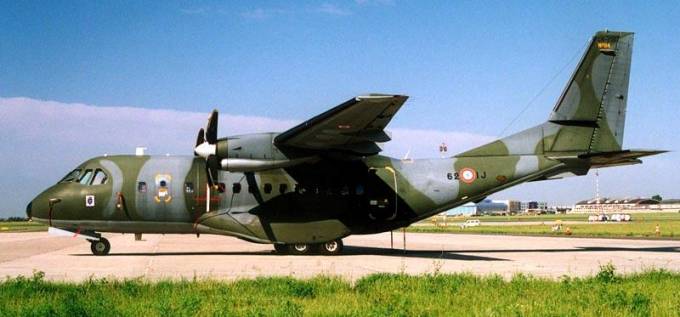
CASA -Nurtanio C-295. 2000.
The CN-235 proved to be a successful design, and this prompted CASA to develop a transport aircraft with a greater range and capacity. The Spanish army would like to see the plane filling the gap between the native CN-235 and the American Lockheed C-130 Hercules, which is a standard NATO plane. Work began in November 1996. The first official information about the new product has already appeared at the Paris airport in 1997. The starting point was the construction and a copy of CN-235 M, which was significantly rebuilt. The main change is the insertion of the 1.50 m fuselage section in front of the wings and also 1.50 m behind the wings. The prototype was designated EC-295. EC mark because the aircraft was to be produced at the ENERA plant in Chile. The rebuilt aircraft took off for the first flight on November 28, 1997. During the tests he made 379 flights in 801 hours. Then the designation was changed to C-295 M. The aircraft obtained all necessary certificates relatively quickly, which allowed CASA to offer it to many potential users.
In 1999, the C-295 was certified; Spanish, French, American. In 1999, Spain signed a contract to provide the Spanish army with 10 C-295 aircraft. Serial production started in 2000, at the CASA plant in Seville and at the ENAER plant in Chile.
Anticipating the facts, we should mention that as a result of signing the contract with Poland, for the purchase of C-295 M, the Spanish company took over the PZL Okęcie plant in Warsaw, where the production of some components for these aircraft was started. A little later a service center and paint shop were established.
The first C-295 M built were rebuilt CN-235 aircraft. By 2008, C-295 M aircraft had been equipped; Spain 13 machines, Poland 12 machines, Jordan 2 machines, Brazil 12 machines, United Arab Emirates 4 machines, Chile 3 machines, Algeria 14 machines, Finland 2 machines, Portugal 12 machines. The C-295 M aircraft is produced in two basic versions; transport (in various configurations) and patrol.
Tender for CASA C-295 M planes for Poland.
The need to equip Polish Military Aviation with a modern lightweight transport aircraft, and in our medium conditions, began to be spoken loud when Poland joined NATO in 1999. At that time, we committed ourselves to modernizing our aviation to Western standards. First of all, it was talked about finding a successor to a successful transport aircraft of the Antonov An-26 type, which bravely served in Poland, but nevertheless got old. Their modernization then carried out only went towards extending the period of their use (resource).
The tender was launched in 2001. Three companies entered the tender; Alenia Aerospazio with Lockheed Martin Alenia Tactical Transport Systems C-27 J Spartan aircraft, CASA with C-295 aircraft and Ukrainian manufacturer with An-32 M-200 aircraft modernized to Western standards. According to the tender organizers, only the offer of the EADS-CASA concern (Construcciones Aeronauticas S.A.) had appropriate certificates documenting compliance with the required standards. The other two offers were rejected. I must admit that this tender did not cause such tensions in Poland as in the case of other competitions. There was a lot of agreement on this topic. There were, however, voices that no aircraft meets Polish requirements. Grievances went towards too small loading hole and cross section, and thus the fuselage does not fit any classic military car. It was true. But Antonov An-26 also did not fit an ordinary car, only with a folding soft roof. The same was done for the C-295 M.
In August 2002, the tender for the purchase of medium (light) transport aircraft for Military Aviation was settled. On August 28, 2001, a contract worth USD 212 million (USD 211,516,192) for the supply of 8 aircraft was signed. The contract was structured in such a way that there were options for the next 4 machines. It was a contract related to offset. The signatories of the agreement were the then Minister of National Defense Bronisław Komorowski from the Republic of Poland and President of the EADS-CASA Alberto Fernandez representing the producer. Pursuant to the provisions of the contract, Poland was to receive eight CASA C-295 M transport aircraft, with the following machine delivery schedule: - 2003 - 2 copies - 2004 - 3 copies - 2005 - 3 copies Payment of invoices for 8 aircraft occurred in eight equal installments over 4 years.
In addition to the delivery of aircraft, the contract provided for the training of pilots and mechanics. The training included 16 pilots, i.e. 8 crews and 30 (initially 15) ground personnel. Two pilots were trained to instructor level. The training program also included rehearsing of refueling procedures in flight, despite the fact that Polish aircraft did not receive appropriate installations. According to the 13 ELTr (Transport Aviation Squadron) full time, there should be two crews per aircraft. This level reached the army in the following years.
There was 12 offset obligations in the delivery contract related to the State Treasury of Poland and EADS-CASA in August 2001. The value of the original offset agreement was USD 212.04 million. The obligations of the foreign supplier - the EADS-CASA group - were to compensate for the costs incurred by Poland related to the purchase of aircraft. One of the largest offset recipients (the entity for which the foreign supplier fulfills the obligation) was the company EADS-PZL Warszawa-Okęcie S.A. From the point of view of the C-295 M user, the commitment to establish an aircraft service center in Poland was important.
Going forward, the knowledge of the Ministry of Economy (in 2005) implied that this commitment was not being implemented properly. It was too early, however, to talk about EADS-CASA's failure to comply with the contract, all the more so as the value of some other projects implemented as part of the offset exceeded the assumed value, and the group fared favorably with other offset providers. Generally, the aircraft manufacturer had until 2011 to fulfill all the provisions of the contract - the contract was concluded for a 10-year period. However, the Ministry of Economy in the face of ineffectiveness of numerous prompts issued in recent years, reacted to signals of delays in creating a service center in Poland and decided to meet representatives of EADS-CASA. A lot was clear then.
When talking about the implementation of the offset obligations, it is necessary to mention the difference between the performance of the obligation and its settlement by the minister competent for economy. The condition for crediting the commitment is the positive result of the ministerial implementation control carried out after the offset submission of the relevant application.
Delivery of CASA C-295 M aircraft to Poland.
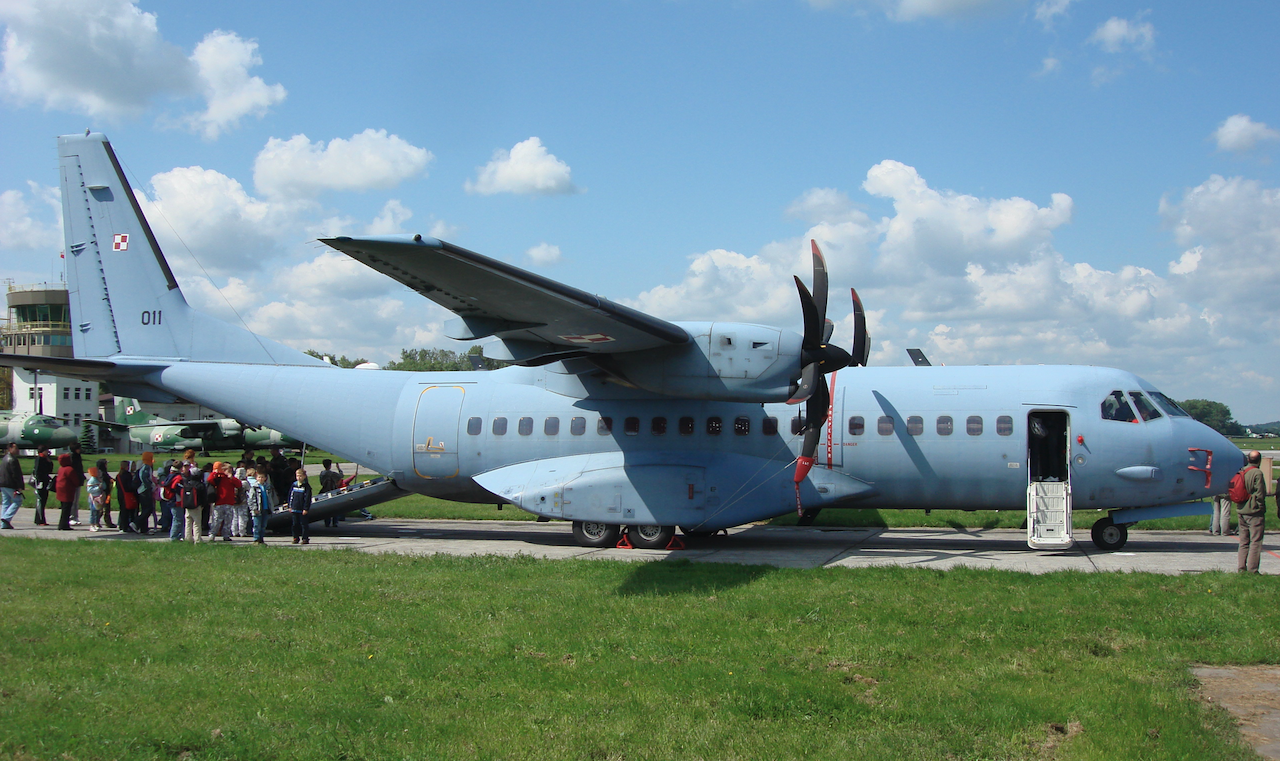
The first of the C-295 M nb 011 aircraft ordered by Poland was taken over by Poles in Spain on August 1, 2003. Intensive training of Polish crews in the air by Spanish instructors lasted for two weeks. The first four pilots trained for the new type flew to C-295 in Spain for 36 hours. Training of further crews and technicians was already continued in the country. This aircraft was brought to Poland to Balice from Seville on August 15, 2003, on the Polish Army Day. The crew commander was major pilot Grzegorz Czerpak. The blue-gray transporter with checkered pattern and number 011 on the fin is the first to become part of the 13th Transport Aviation Squadron.
The second C-295 M nb 012 was to be taken over by the Polish side on August 18, 2003, but due to the malfunction of one of the Pratt-Whitney Canada PW 127 G engines with 2 x 1 944 kW (2 x 2 645 HP), procedure was delayed until the beginning of September 2003. Eventually, the plane flew to Krakow on 8.09.2003.
The next three planes were planned to be delivered to Krakow in mid-2004, and the last three in 2005.
Meanwhile, in the middle of August 2003, the issue of WAT stamp duty was not resolved. The first plane, after arriving in Krakow, was sealed until the Ministry of Defense paid a tax of approximately USD 5 million. Well, somebody didn't react properly.
By the end of 2003, aircraft were heavily used for further crew training.
The new aircraft have a maximum take-off mass of over 23 tons, with a maximum payload of 9 tons (An-26 - over 6 tons). The hold holds 71 soldiers with equipment. The cargo cabin is 12.7 m long, 2.36 m wide and 1.9 m high and (An-26 11.5 m, 2.4 m and 1.9 m respectively). It was generally said (2003) that the C-295 is twice as good as the An-26 because it flies twice as far and takes twice as much cargo.
The range of the C-295 with a payload of 8 tons is about 2,200 km, which allows flights to most places in Europe. For example - from Kraków to Baghdad (Iraq) there are about 2,800 km in a straight line. According to the manufacturer, the maximum range is over 5,600 km, which at a cruising speed of 480 km / h means over 10 hours of flight (e.g. about 5,300 km from Krakow to Delhi, India). New on transport aircraft of the Air Force and Air Defense (currently 2009: Air Force) are defense systems - C-295 are equipped with flares and traps against anti-aircraft missiles.
Power unit C-295 M - Pratt & Whitney Canada PW127G (used, among others, in ATR 72). Six-blade propeller Hamilton Standard 568F-5. C-295 M planes are designed to use grassy runways.
We will add from the chronicle duty that the nb 011 aircraft is the second C-295 M with checkerboard flight. The first was the de facto Spanish aircraft number XT.21-02, which had a chessboard glued on during the demonstrations in Radom in 2002 (on wings and a fin).
On July 28, 2005, Krakow ELEL 13 received the last of the first series of eight ordered transport aircraft EDAS CASA C-295 M. On this occasion, a ceremony was held with the handing over of the aircraft unit by the Minister of National Defense. This aircraft flew to Balice on August 23, 2005.
The invoice for 8 aircraft was repaid in eight equal installments over 4 years. Due to the stable financing of the Ministry of National Defense by the budget of the Republic of Poland, the repayment was regular and even slightly ahead of schedule. This resulted in faster delivery of aircraft to Poland. The favorable exchange rate of the Polish currency, Polish Zloty, saved a few million dollars. They were used to retrofit machines. The relevant annex was signed on November 16, 2004. The main attention was paid to the elements of self-defense. Mainly Indra ALR-300 (V2) R radiation warning system. Warning system against fired anti-aircraft missiles EDAS AN / AAR-60 MILD (Missile Launch Detection System). Four sets of titanium-composite cabin armor. Medical evacuation kits. Medical kits (resuscitation and life support). Fast loading and drop-off systems in flight. For all Polish C-295 M aircraft, a IFF Raytheon APX-100 system transponder has been provided. Eight thermal and radar trap ejectors BAE Systems AN / ALE-47. The first aircraft with such additional equipment was created during the warranty review in Spain.
The aircraft received uniform light blue-gray painting and side numbers from 011 to 018 (in several cases they correspond to the factory numbers).
In view of the needs of the Air Force involved in the implementation of tasks related to the presence of Polish Military Contingents outside the country (mainly Iraq, Afghanistan and the Balkans), in December 2006 Poland decided to increase the number of C-295 M. aircraft ownership. On 22.12.2006 year, an appropriate annex was signed. Planes that received nb 019 and 020 reached 13 ELTr in August and September 2007. Since then, the Krakow Squadron has been a user of 10 C-295 M aircraft.
In October 2007, another annex to the original contract was signed, which concerned the purchase of two aircraft along with a package of additional equipment and spare parts. The favorable exchange rate of the Polish currency favored the situation. But it doesn't stop there. Using the possibility of extending the concluded contract, in August 2001 annexes were signed, under which the subject of the contract was increased by further elements of the aircraft equipment. The increase in the subject of the delivery contract resulted in the signing, on February 19, 2007, of the first annex to the offset agreement, increasing its value by USD 94.32 million. The annex related to another 12 offset liabilities. Four of them concerned the company ETC-PZL Aerospace Industries Sp. z o.o. It was associated with: the production of equipment for training catapulting procedures, used at the Military Institute of Aviation Medicine, Dęblin's "School of Eaglets" or 31st Air Base in Krzesiny (device designed for training F-16 pilots).
A few months later, on October 30, 2007, the original contract for the purchase of C-295 M aircraft was extended once again: Undersecretary of State at the Ministry of National Defense Bartłomiej Grabski signed the document - Annex No. 13 - regarding the purchase of two more machines with a large package of additional equipment and spare parts.
After several years of intensive operation of aircraft by the Air Force, they were given a positive assessment - they successfully enabled the implementation of tasks related to supplying Polish and allied troops involved in international missions in various parts of the world. Therefore, it was decided to increase their number to 12. The meeting during which the annex was signed was attended by the President of EADS-PZL Jose Leal, Spanish Ambassador in Poland Rafael Mendivil, Military Attache of the Spanish Embassy in Poland, Col. Carlos Hernando Guttieres, Aleksandra Dyka from the Department of Offset Programs Ministry of Economy, Commander of the Air Force general of arms pil. Andrzej Błasik and director of the Armed Forces Supply Department, Brig. Sławomir Szczepaniak. The annex also provided for training of further Polish crews.
Four more CASA C-295 M planes were painted solid gray.
However, in order for the deliveries to be made, it was necessary to sign, within 60 days, Annex 2 to the original offset agreement between the State Treasury and the producer, the EADS-CASA group. On December 21, 2007, such a document was signed by the Minister of Economy, Deputy Prime Minister Waldemar Pawlak, and on the part of the producer, Vice President for Offset Gabriel Alonso. The annex increased the value of the offset agreement by USD 78.70 million and currently its value amounted to USD 385.58 million. Pursuant to the provisions of Annex No. 13, two CASA C-295 M aircraft appeared in Poland in autumn 2008.
Operation of CASA C-295 M aircraft in Poland.
One of the main tasks was to maintain shuttle communication between the Republic of Poland and the Polish Military Contingent stationed in Iraq. We would like to remind you that in August 2003, 2,500 soldiers were sent to the region of the Iraqi stabilization mission - so the Polish transport aviation faced a challenge to secure the provisioning of the contingent.
What was the flight like? About how dangerous these flights were, we will say that Polish crews flew there in bulletproof vests and with personal weapons, but without parachutes. The plane flew from Balice to Starachowice. The local airport, then the 3rd Air Base, was part of the 3rd Transport Aviation Brigade. The airport had logistics facilities to handle foreign flights. The second reason was the proximity of military units that had their soldiers on missions. After loading and customs clearance, the Polish transporter flew over Ukraine and Moldova, or the Balkans. Then at the Black Sea. The plane landed in Baku, the capital of Azerbaijan. There was a stopover here. After taking off from Baku, he flew over the Caspian Sea and Turkmenistan. Next are the Mountains of Afghanistan and the airports in Kabul or Bagram. Sometimes planes flew to Sharan, where there was the Polish Combat Group. There was a primitive airport. Built on a stony surface, 2,500 m above sea level. DS (RWY) was 1,400 m and only 18 m wide when the C-295 span was almost 26 m. All flights to Afghanistan were carried out during the day. After dark there was a ban on flights.
Flights to Iraq were also dangerous. If the aircraft carried over 5,000 kg of cargo, the stopover took place in Turkey, Ankara airport or Trabzon.
Polish C-295 M also performed other record flights. In January 2007, aircraft carried illegal immigrants to Vietnam through Afghanistan and India.
Praise for the aircraft, however, did not change the fact that it is a relatively slow, noisy plane and belongs to smaller transporters, and the Republic of Poland uses it as a strategic plane. The more recognition I have for the pilots of these machines. The flight to Afghanistan can last over 13 hours. According to the procedure, the pilot should have a minimum break of 24 hours, which was not always possible.
In 2005, due to the huge demand for transport flights, C-295 M aircraft significantly exceed the average in the Air Force with their annual flight time. Record holders have reached 400 hours of flight a year. At that time, 13 ELTrs were in stock 10 An-26 aircraft, several 18-seat M 28 Bryza, several An-2, rescue Mi-8 RL helicopter and several Mi-2 helicopters. In 2006, the C-295 M raid exceeded 6,300 hours. Periodic inspections of the aircraft were / are carried out in Balice.
One cannot fail to mention the planned use of the C-295 M for the landing of the subunits of the 6th Assault Brigade. Plans to adapt aircraft to parachute equipment operated in Poland have not been fully implemented, for a simple reason. The decision of the commanders, for the needs of the landing skydivers, began to use the smaller M-28.
Operation C-295 M. 2007.
Until November 2007, 13 ELTr was the only transport unit in Poland. In November 2007, 14 ELTr was established at the Powidz airport. All C-295 M are still in operation in Balice. The raid is divided into training and disposable. In disposable flights, we have a division into service, operational and own flight time. Polish C-295 M mainly perform school and operational flights. School flights account for about 30% of the total flight time. It is relatively a lot. This is due to the lack of simulators that CASA has not yet developed and we need to conduct all pilot training on airplanes. We do not have another plane which would be piloted to the C-295 M. Aircraft operation is so intense that 100% of planned flights have already been completed in October. The plan assumed 3,500 hours in the air. At that time, An-26 aircraft were in the air for only 750 hours.
Aircraft records at 13 ELTr as at September 30, 2007.
- C-295 M Nb 011, 012, 013, 014, 015, 016, 017, 018, 019, 020
- An-26 Nb 1403, 1406, 1509, 1602, 1603
- M-28 Nb 0208, 0209, 0210, 0211, 0212, 0213, 0214, 0215, 0216, 0217
- An-2 Nb 0852, 7447
C-295 M. disaster 2008.
On January 23, 2008, one of the planes (nb 019) crashed near Mirosławiec during landing. 20 Air Force soldiers were killed in the disaster, the machine was destroyed. The tragedy is described in a separate article.
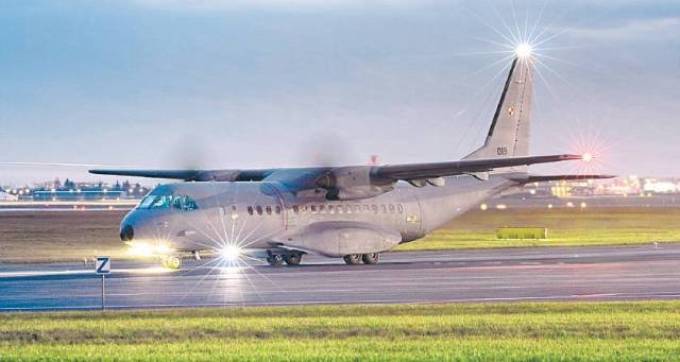
Training on Radio-Electronic Combat for C-295 M crews.
In the 3rd Transport Aviation Brigade (3rd BLTr) in Powidz on 26-27.06.2008. training in the field of Electronic Combat of the C-295 M aircraft took place. The training organized by the reconnaissance section 3. BLTr was attended by: representative of the A-2 Board of the Air Force Command, representative 1. ORel, representative of reconnaissance section 2. BLT, reconnaissance section 13. ELTr, pilots and technicians of WRE devices from 13. ELTr. The purpose of the training was to familiarize the staff with basic information about Electronic Fight, the possibilities of devices for Electronic Defense on the C-295 M aircraft, the principles of developing the library on threats and the principles of missile maneuvers. The meeting of specialists from so many air units was an excellent opportunity to exchange experience in the field of radio-electronic combat and reconnaissance.
Last C-295 M delivered. 2008 year.
On December 19, 2008, the last ordered CASA C-295 M nb 022 landed at Balice airport. The plane arrived in Poland three days earlier. The aircraft belongs to the production series PO 02 and has richer equipment than previously received copies. At the moment, 13 machines of this type were in stock at 13 ELTr. Minister of National Defense Bogdan Klich took part in the ceremony. Minister Bogdan Klich praised the plane, noting on its usefulness in the implementation of transport tasks of Polish military contingents outside the country. The minister reminded that two weeks earlier the deliveries of F-16 Jastrząb fighters had been made.
The quantity of transport aircraft of the 3rd Transport Aviation Brigade in Powidz (13 ELTr in Balice) and the 36th Special Transport Aviation Regiment in Warsaw at the end of 2008 was as follows; An-28 - 2 copies, M-28 - 15 copies, Yak-40 - 4 copies, Tu-154 M - 2 copies, C-295 M - 11 copies. In 2008, the last Antonov An-26 aircraft - 5 units, and PZL An-2 aircraft - 10 units were withdrawn.
Written by Karol Placha Hetman
Kraków 2009-05-05
311b Section 2003-08-01
Construcciones Aeronauticas SA ( EDAS CASA ) C-295 M
Poland
Construction
Transport plane.
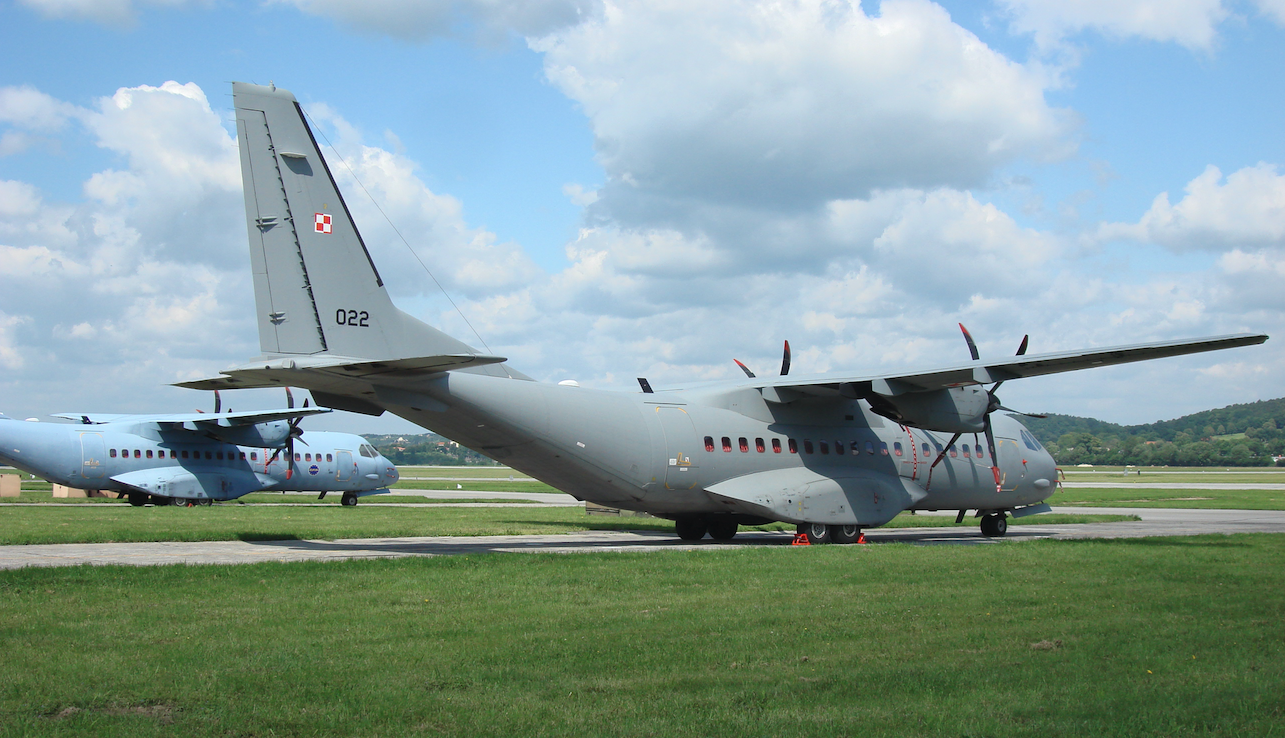
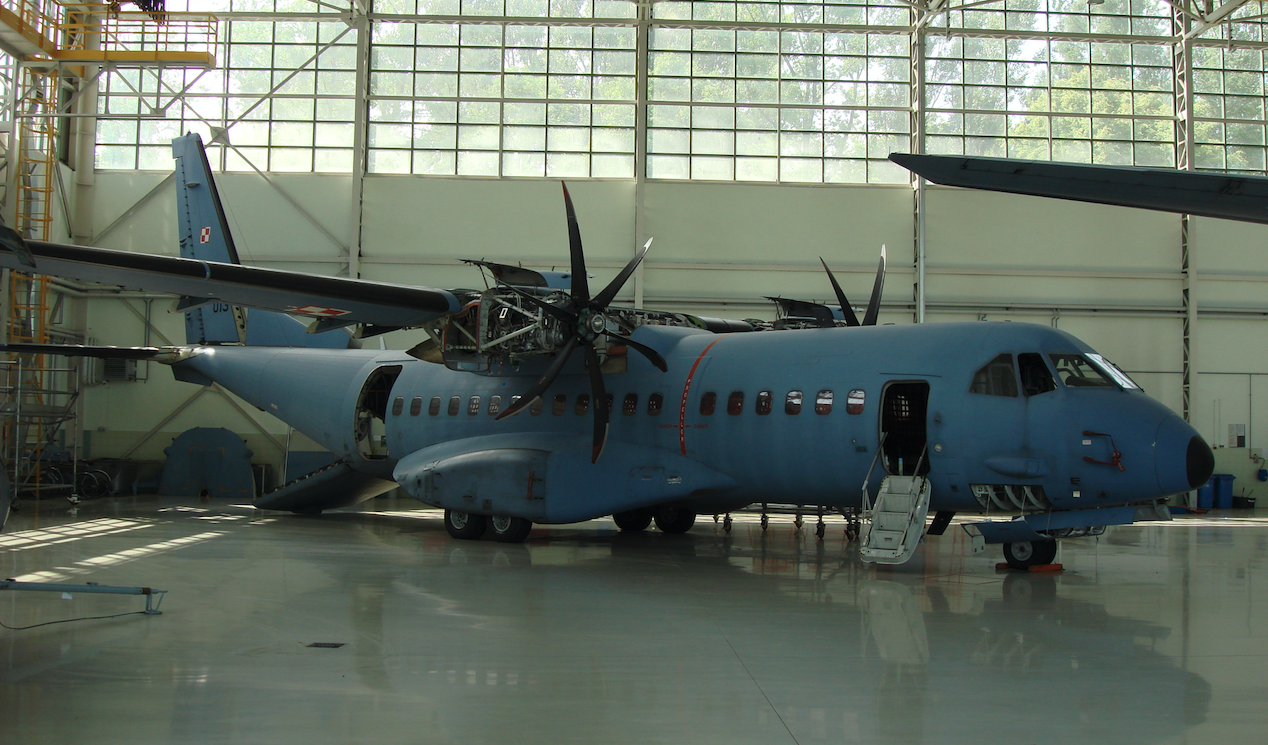

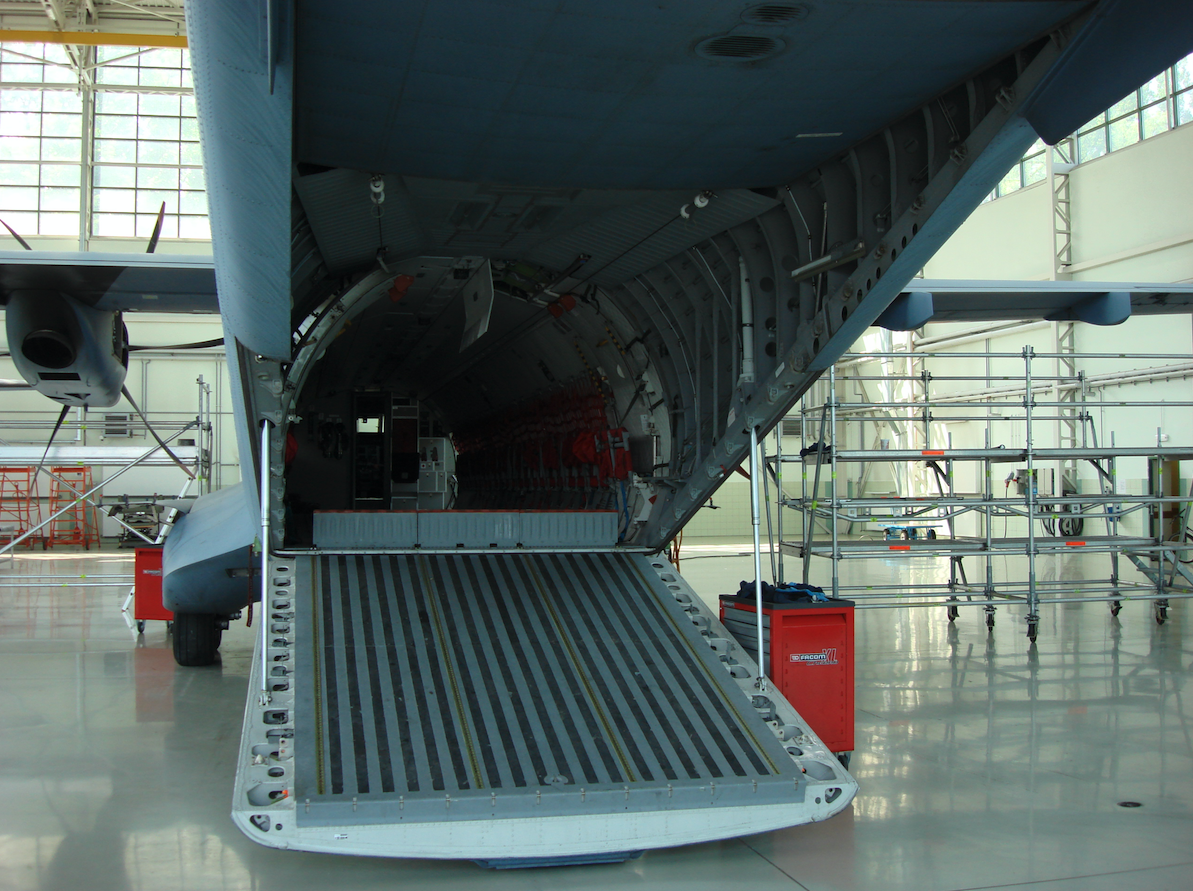
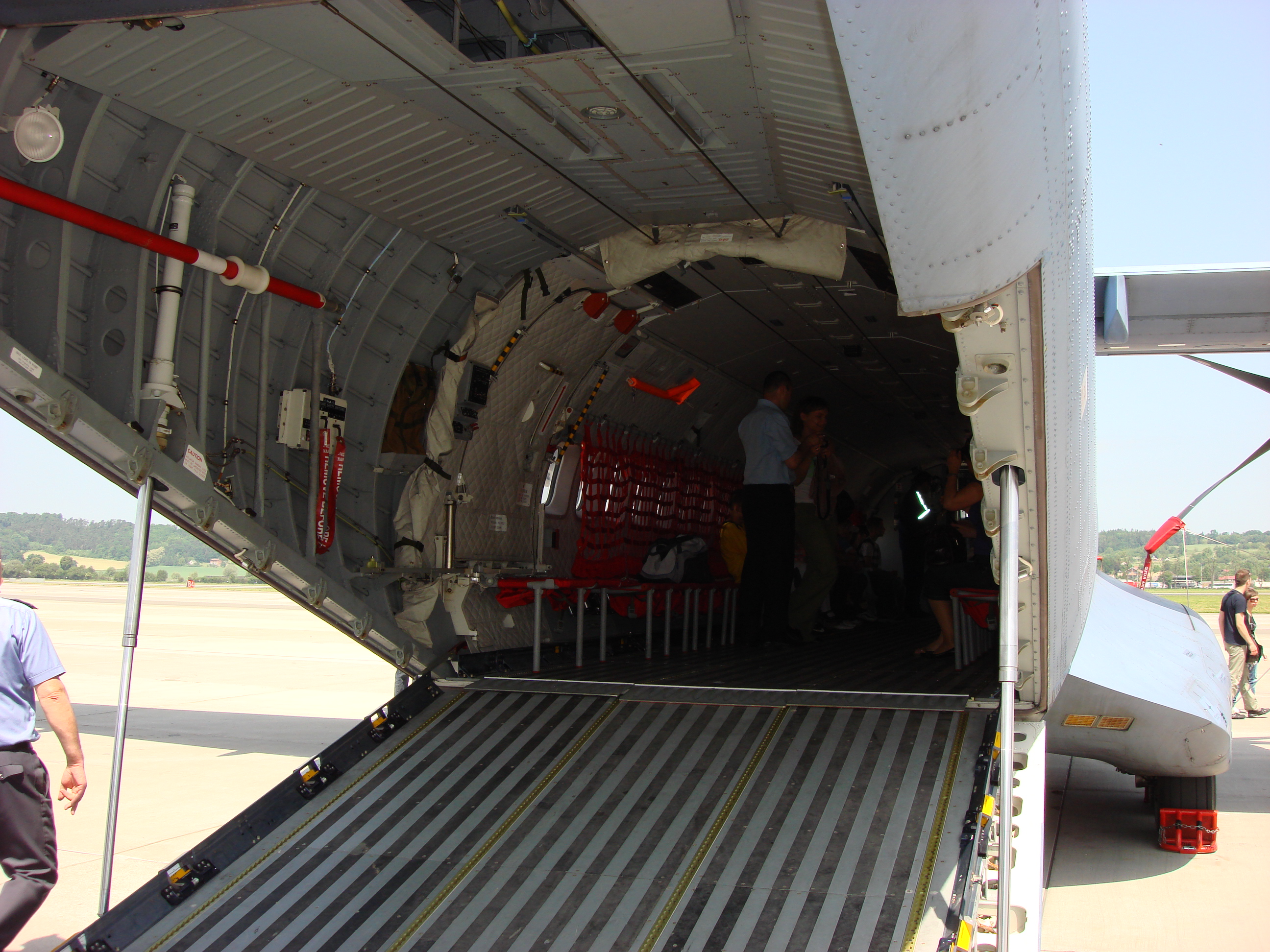
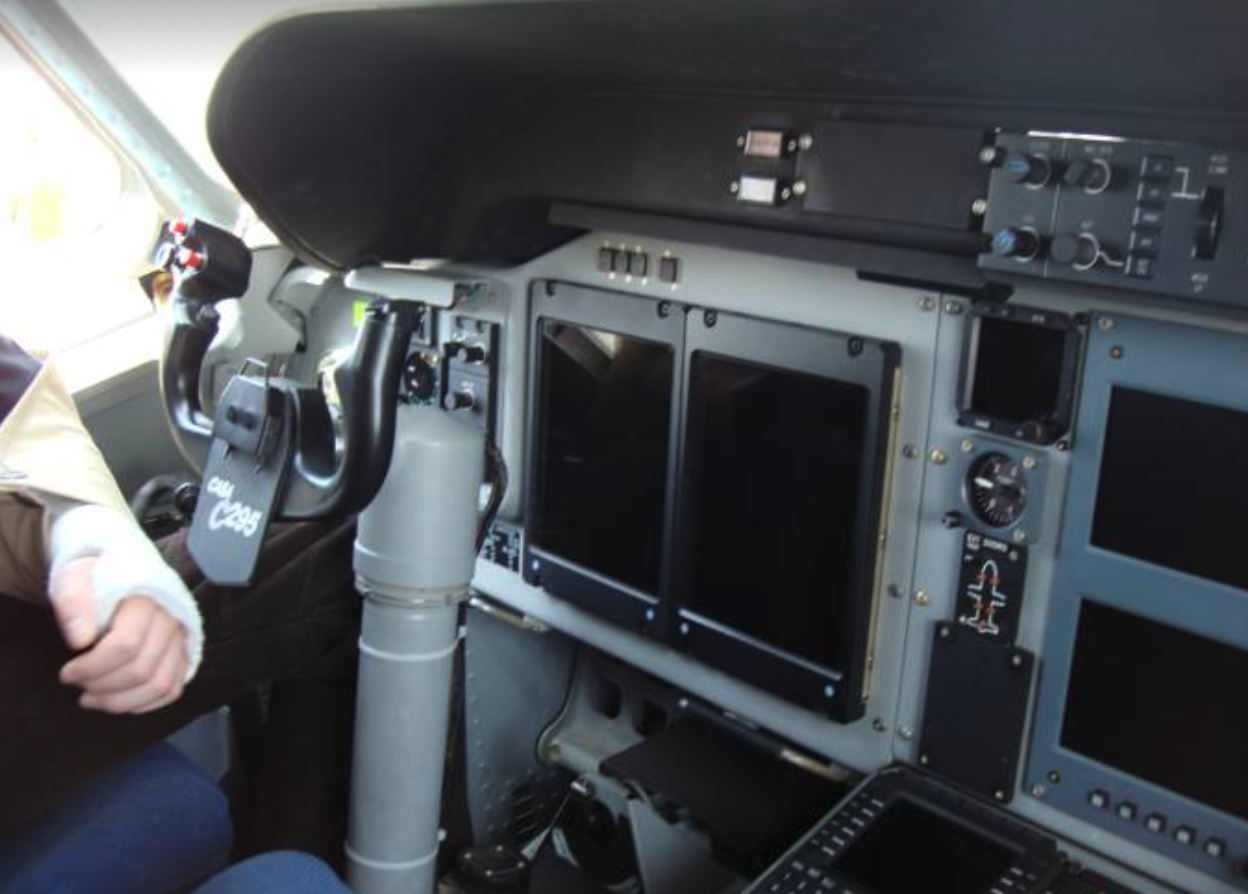
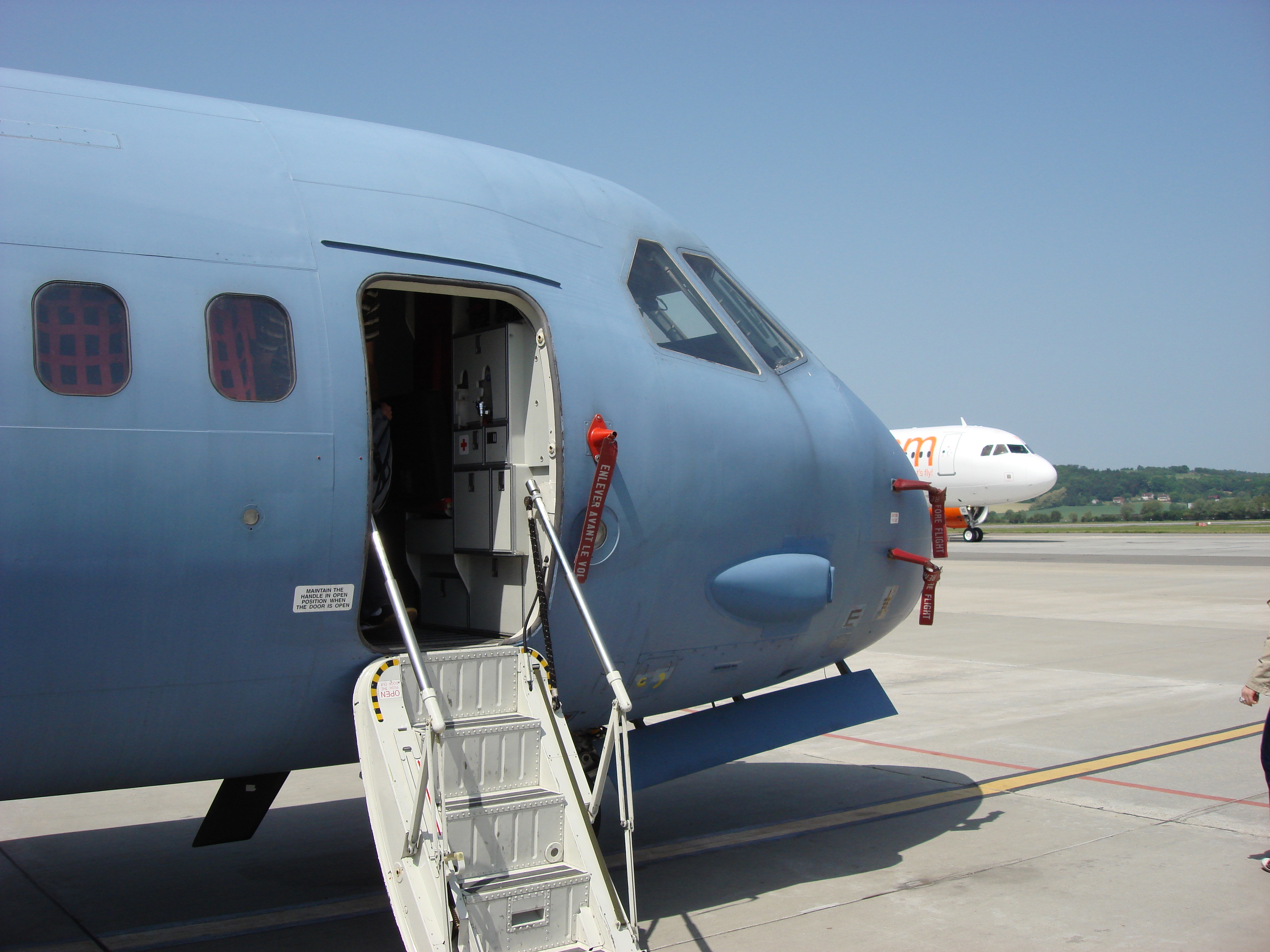
Construction CASA C-295 M.
CASA C-295 M is a high-wing composite-metal structure, built in a classic layout. The aircraft is powered by two turbo-propeller engines.
Straight sashes have a three-part, metal and double-girder structure. The central part is a center wing with a rectangular contour. The external parts have a trapezoidal outline. NACA 65-218 airfoil profile with an external riser of 3 degrees. Double-gap flaps occupy 58% of the wingspan. The ends of the lobe take ailerons. The wings were equipped with an ice protection system. Under the wings there are catches for 6 knots under the wings for; armaments, reconnaissance or other means. Fuel tanks were placed in the wings.
The fuselage has a metal structure, half-shell, with an oval section with a flattened end of the loading ramp. The cabin is pressurized. The fuselage begins with a two-seater cockpit. The left seat is occupied by the captain-commander, the right by the second pilot. The crew can be completed by a third member who acts as loading technician. For the technician, the place is in the hold. The hold has a length of 12.60 (12.70) m. The maximum height in section A, in the front is 1.82 m, in section B, in the middle is 1.87 m. The useful width in part B is 2.34 m ( 2.10 m on the floor), but through the loading ramp in part D, objects with a height of 1.70 m will fit. Generally, it can be said that containers can be loaded with a length of 2.00 m and height of 1.70 m. Door to the holds are made of two parts. One part has hinges at the bottom and after lowering it is a loading ramp. The second part has hinges at the top and lifts upwards into the hull. The transport cabin can be composed in various ways. In the transport compartment, it is possible to transport cargo on five standard pallets (NATO standard) and folding seats at the sides of the cabin. In the passenger variant up to 30 soft seats can be mounted. The medical version allows 24 people to be transported on a stretcher. This option was used for the first time in October 2003, during transport to the country of tourists injured in Egypt in the event of a coach. The plane can take a maximum of 71-78 people. The maximum load weight can be around 9,500 kg. You should also remember about the strength limits of the cargo floor. There is a toilet on board the aircraft, which is a revolution in this class of machines. 19 windows and doors at the front and rear were placed in the right side of the fuselage. There are 18 windows and doors at the rear side of the port.
The size of the C-295 M and An-26 aircraft holds is comparable. Both have limited ability to carry military vehicles. An-26 took one Gaz-69 / Uaz-469 passenger car off-board with a folded soft roof and a lowered windscreen. Similarly, the C-295 M takes one Honker off-road vehicle, also with the roof removed.
The tail of the C-295 M is classic.
Three-support chassis, retractable in flight, adapted to use of ground airports. Low pressure pneumatics. Oil and gas shock absorbers. Front chassis with double wheels, controlled, fully retractable into the fuselage under the cockpit. Main landing gear supported in nacelles at the hull. Two wheels on each side, arranged in tandem. The main chassis is a type of doubled independent chassis. Each wheel has its own shin. The main landing gear has the option of shortening the shin when the vehicle is stationary and the plane lowers as if squatting. As a result, the cargo floor lowers lower, making loading easier. All wheels have hydraulic disc brakes.
C-295 M powered.
The C-295 M drive consists of two Pratt & Whitney of Canada PW C-127G turbine engines with a normal power of 2 x 1 927 kW (2 x 2 645 HP) and a maximum of 2 x 2 177 kW.
Six-blade propellers Hamilton, with variable pitch. 3.90 m diameter.
Engines consume fuel, depending on the load taken, weather conditions, flight altitude and ceiling, from 400 kg to 800 kg of fuel per hour of flight. The maximum flight range is 5,600 km, at a ceiling of 7,800 m. At 4,000 kg, the aircraft will fly to Iraq without stopping.
The fuel supply of 7,700 liters is stored in four fuel tanks located in the wings. The aircraft has the option of assembling refueling installations in flight. Polish aircraft do not have this installation.
Aircraft equipment C-295 M.
The aircraft control is doubled, corded with hydraulic assistance. The flaps on the wings are swung out hydraulically, and the balancing flaps are moved electromechanically.
Avionics of the C-295 M.
The aircraft avionics is modern. Avionics was developed and built by Thales Topdeck. Avionics includes, among others; FMS Gemini 3000, autopilot, RDR-1400C weather radar, TCAS, AN / ARC-210 radio with encryption capability, HF-9087D radio, GPS Topstar-100, IFF AN / APX-100 transponder, VOR / ILS Thales TLS- receiver 2200, satellite telephone, TACAN system, Digital Moving Map, EGPWS (Enhanced Ground Proximity Warning System). The aircraft has the option of installing a third VHF radio station and a second HF radio station. The GPS system can be extended with the INS / GPS platform.
The aircraft is equipped with the Indra AN / ALR-300 V2B integrated self-defense system, which includes a receiver that warns of radiation irradiation. In order to confuse missiles, eight 12-barrel dipole and flare ALE-47 flares are installed on board. Self-defense system on airplanes flying to Iraq or Afghanistan is a must, when starting and landing firing thermal traps is a standard activity. Initially, Poland bought two sets of RWR systems with a view to mounting them on a particular aircraft in installments. Due to the involvement of our country in the wars in Iraq and Afghanistan and favorable financial settlements for the purchase of aircraft (stronger zloty) in 2004 it was decided to purchase additional kits and retrofit planes with missile detectors (MILDS) AN / AAR-60 and crew armor, at least on 4 planes. Optionally, you can also install cockpit armor, protecting against small-caliber weapons and projectile shrapnel.
Other data of the C-295 M.
The maximum weight of the aircraft is 23,200 kg. The empty plane weighs 12,500 kg. To this can be combined armor (300 kg) and combat systems WRe, and then the empty plane weighs 13,000 kg. The plane can be loaded with 9,500 kg, with cargo and fuel. The minimum fuel supply is 2,000 kg, and then the aircraft takes 7,000 kg of cargo, but the range will not exceed 1,000 km and 3 hours of flight. Usually, for foreign missions, e.g. to Afghanistan, the plane takes 4,000 kg of fuel and 5,000 cargo. The aircraft burns on average 600 kg of fuel per 1 hour of flight (An-26 burned 1 100 kg of fuel per 1 hour of flight). The aircraft can stay in the air for 12 hours (An-26 to 6 hours). The record flight of Polish C-295 M was 10 hours 10 minutes, with a reserve for a further 1.5 hours of flight. The operating ceiling is 7,600 m, but can be reached without a load of 9,000 m.
All inspections and repairs of Spanish transport aircraft are carried out in the country. Specialist Group of the 8th Air Base in Krakow-Balice specialized in this. Current service is also performed by the technical staff of the home squadron. The 8th Air Base Technical Maintenance Group performs the entire scope of periodic maintenance according to the agreed service schedule. Such operations are carried out after a specified period of operation of the aircraft or after spending a certain number of hours in the air.
T-T data of the C-295 M aircraft
Span - 25.81 m
Length - 24.45 m
Height - 8.66 m
Curb weight - 10,760 - 12,500 kg
Total weight - 21,000 kg
Maximum weight - 23,200 kg
Load weight - 9 500 kg
Fuel quantity - 7,700 liters
Max speed - 480 km / h
Cruising speed - 420 - 460 km / h
Maximum range - 5,630 km
Range with maximum load - 2,300 km
Ceiling - 7,600 - 9,145 m
Run up / run down - 800-840 / 490 - 680 m
Propulsion - two Pratt Whitney Canada PW127G turboprop engines with 2 x 1972 kW each
Crew - 2-3 people
17 aircraft purchased (1 aircraft lost)
Written by Karol Placha Hetman
Kraków 2009-05-05
311b Section 2003-08-01
Construcciones Aeronauticas SA ( EDAS CASA ) C-295 M
Poland
Tally
Transport plane
1 CASA C-295 M nb 011. Shipped on 2003-08-01. The aircraft was taken over by the Polish Forces in Spain and was used to train the first Polish crews.
2 CASA C-295 M nb 012. Supplied on September 9, 2003. Delivered with a slight delay due to the need to replace the engine.
3 CASA C-295 M nb 013. Delivered in 2004.
4 CASA C-295 M nb 014. Delivered in 2004.
5 CASA C-295 M nb 015. Delivered in 2004.
6 CASA C-295 M nb 016. Delivered in 2005.
7 CASA C-295 M nb 017. Delivered in 2005.
8 CASA C-295 M nb 018. Delivered in July 23, 2005. The last plane from the first tranche.
9 CASA C-295 M nb 019. Delivered in August 2007. The first of four aircraft of the second tranche. On January 23, 2008, it suffered a disaster in Mirosławiec.
10 CASA C-295 M nb 020. Delivered in September 2007.
11 CASA C-295 M nb 021. Delivered in 2008.
12 CASA C-295 M nb 022. Delivered on December 19, 2008. The last plane from the second tranche.
13 CASA C-295 M nb 023. Delivered in 06.10.2012. The first of the third tranche of five aircraft.
14 CASA C-295 M nb 024. Delivered in 06.10.2012.
15 CASA C-295 M nb 025. Delivered in 2013.
16 CASA C-295 M nb 026. Delivered on November 2, 2013.
17 CASA C-295 M nb 027. Delivered on November 2, 2013. The last of the third tranche of five aircraft.
Written by Karol Placha Hetman
